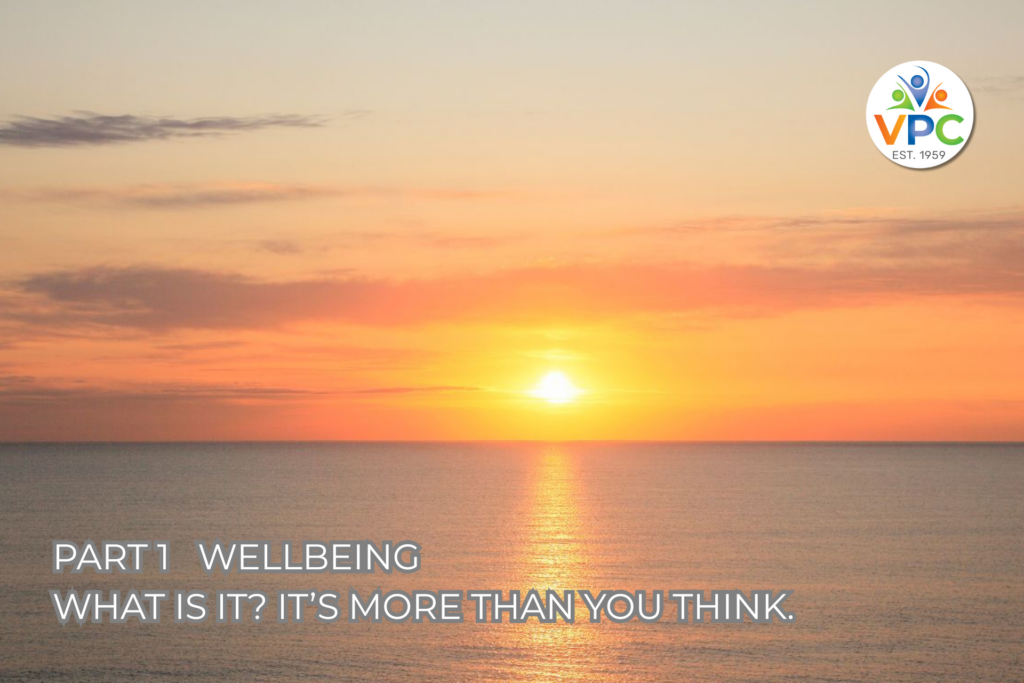
WELLBEING: WHAT IS IT? IT’S MORE THAN YOU THINK – PART 1
In today’s world, the word “wellbeing” seems to be everywhere. Schools run well-being programs, podcasts promise to boost it, and wellness brands build entire identities around it. Addressing wellbeing has become a focus in parenting forums, workplace policies, and government strategies. Wellbeing has become a kind of shorthand, often reduced to things like mental health, self-care, or happiness, without recognising the broader influences and how they all interconnect.
It is easy to assume wellbeing is a modern term that means “feeling good” or “staying healthy.” But the concept has a much deeper history and a richer meaning. Thinkers, from ancient philosophers to contemporary psychologists, have been exploring what it means to live well for centuries. The desire to feel better and live with purpose and peace is a timeless part of being human. In today’s world, where many of us are navigating constant noise, pressure, and uncertainty, understanding what wellbeing really is and why it matters is more important than ever.
As parents, it is easy to place your own needs low on the ladder or overlook their importance. However, your wellbeing isn’t solely yours; it is necessarily shared with your children and others you care for. You can’t pour into others from the proverbial empty cup. A well parent is better able to regulate emotions, model healthy coping, and provide the steady presence that children need to build resilience.
This is the first in a series of blogs that explore wellbeing and its various components. This piece will examine how the concept has evolved and what it means today. In parts two and three, we will explore how practices like mindfulness and meditation can support and enhance your personal well-being, as well as how the concept has changed over time.
Where did it all begin?
Aristotle
The concept of being a ‘well’ ‘being’ can be traced back to ancient Greece and one of the better-known philosophers, Aristotle, who introduced us to the word “eudaimonia. ” He used the word eudaimonia to describe a life of deep fulfilment, which is not just feeling happy, but genuinely flourishing. He believed that humans thrive when they use their ability to think clearly and make wise choices. This meant living with purpose, developing good habits, and finding balance. Aristotle called this balance the golden mean, which is the idea that avoiding extremes is the best way to live. For example, courage sits in the middle ground between being too reckless and being too afraid. For Aristotle, well-being wasn’t about constant pleasure, but about living a thoughtful, balanced life.
Maslows Hierachy of needs
In the 1940s, psychologist Abraham Maslow offered a fresh perspective on what humans need to thrive. He described wellbeing as a ladder of needs, with basic physical needs, such as food and safety, at the bottom, and higher emotional and psychological needs—like love, belonging, and self-esteem—above. At the top, Maslow placed self-actualisation: the idea of reaching your full potential and living a meaningful, authentic life. His model reminds us that wellbeing is layered. We cannot expect to feel fulfilled or balanced if our more basic needs are constantly under threat. For parents, this can help explain why some days feel like survival mode; it’s difficult to reach for “your best self” when sleep and security are in short supply.
Carl Rogers
Around the same time, psychologist Carl Rogers added another essential piece to the wellbeing puzzle. He believed that people grow best in environments where they feel accepted, understood, and valued. This is what he referred to as “unconditional positive regard.” Rogers saw wellbeing as something deeply connected to self-worth and emotional safety. When you feel safe to be yourself, without fear of judgement, you are more likely to thrive. Feeling “enough” is part of the foundation for wellbeing.
Positive psychology and the dawn of vulnerability.
Fast forward to the late 20th and early 21st century, and a growing movement called positive psychology began asking: what helps people not just cope, but actually flourish? Psychologists like Martin Seligman and researchers like Brené Brown began to explore the roles of optimism, meaning, connection, and even vulnerability in living a well life. Brown, in particular, highlighted how wellbeing is not about perfection or always being in control—it’s about having the courage to be real, to connect with others, and to embrace the full range of human emotions. Across time and theory, a clear thread emerges: the pursuit of wellbeing is a deep and universal part of being human. Whether it’s Aristotle’s balance, Maslow’s ladder, or the power of connection and courage, the message is clear—wellbeing isn’t a trend, it’s a timeless need.
Throughout the centuries, thinkers ranging from Aristotle with his concept of eudaimonia to Maslow with his hierarchy of needs, along with Carl Rogers’ emphasis on acceptance and Brené Brown’s advocacy for vulnerability, have explored what it means to live well. Despite their differing language and theories, they all convey a central truth: wellbeing encompasses more than mere survival. It involves thriving in a manner that feels authentic, balanced, and meaningful.
Wellbeing fundamentally involves asking yourself, “How am I really doing, considering everything?” It encourages you to reflect on your entire self—encompassing your physical, mental, emotional, social, and spiritual health. It also involves paying attention to your surroundings, including your relationships, work, finances, responsibilities, and the overall pace of life. The reality is that your inner world is influenced by your outer one. Checking in with your wellbeing means tuning into your body, thoughts, energy, and emotions, and recognising how life’s pressures and experiences are affecting you right now.
To clarify, here are some key internal and external factors that influence well-being, which may help you better understand what supports or challenges your own.
Internal factors:
- Emotional – how we process feelings like joy, sadness, anger or stress
- Mental – how clearly we think and how well we can cope with challenges
- Physical – our body’s health, energy, and how we feel day to day
- Social – the quality of our relationships and sense of connection
- Spiritual – our sense of purpose, meaning, or connection to something bigger
External factors:
- Financial – stability and income
- Employment – that is secure and meaningful
- Education – access and quality
- Health care – access to medical and allied care, good nutrition, or rest)
- Housing – safe, stable living conditions and access to green space
- Culture – connection to meaningful social and cultural conditions
These elements do not exist in isolation; they constantly interact and influence each other. For example, living with chronic pain can make it more difficult to maintain emotional stability. Conversely, having strong friendships or a spiritual foundation can support you in managing emotional highs and lows. Additionally, a good education can lead to better job opportunities, which in turn can contribute to financial and mental well-being. When our mental health deteriorates, it can affect our ability to learn, connect with others, and thrive.
Although these connections can be complex, one reassuring truth is that wellbeing is not a fixed state. It can shift and change over time, meaning there is always the possibility for positive change in a forward direction.
In Part 2 of this blog, we will explore methods to measure your wellbeing and how you can gain a better understanding of your baseline.
Katrina Gow
Katrina is a compassionate and skilled counsellor dedicated to fostering mental health and resilience. In 2025, she will contribute her expertise as an advisor to a Deakin University project addressing school attendance issues, helping develop strategies for improving educational outcomes. Additionally, Katrina is part of the Victorian Parents Council team and writes insightful blogs for the VPC, offering support and guidance to parents navigating challenges in education and parenting. Through her work, she strives to create positive change in both individual lives and broader community settings.
References
Brown, B 2012, Daring Greatly: How the Courage to Be Vulnerable Transforms the Way We Live, Love, Parent, and Lead., Penguin Random House Audio Publishing Group.
Cornelius-White, J 2007, ‘Learner-centered teacher-student relationships are effective: A meta-analysis’, Review of Educational Research, vol. 77, no. 1, pp. 113–143.https://doi.org/10.3102/003465430298563
Huta, V & Waterman, AS 2014, ‘Eudaimonia and Its Distinction from Hedonia: Developing a Classification and Terminology for Understanding Conceptual and Operational Definitions’, Journal of Happiness Studies, vol. 15, no. 6, pp. 1425–1456.https://doi.org/10.1007/s10902-013-9485-0
Kenrick, DT, Griskevicius, V, Neuberg, SL & Schaller, M 2010, ‘Renovating the Pyramid of Needs’, Perspectives on Psychological Science, vol. 5, no. 3, pp. 292–314.https://doi.org/10.1177/1745691610369469
Maslow, AH 1943, ‘A Theory of Human Motivation’, Psychological Review, vol. 50, no. 4, pp. 370–396. https://doi.org/10.1037/h0054346
Rogers, C 1961, On becoming a person: A therapist’s view of psychotherapy, Houghton Mifflin, Boston.
Seligman, MEP & Csikszentmihalyi, M 2000, ‘Positive psychology: An introduction’, American Psychologist, vol. 55, no. 1, pp. 5–14. https://doi.org/10.1037/0003-066X.55.1.5

